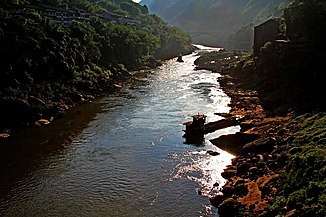Chishui He
|
Chishui He 赤水 河 |
||
| Data | ||
| location |
Guizhou , Sichuan , Yunnan , PRC |
|
| River system | Yangtze River | |
| Drain over | Yangtze River → East China Sea | |
| source | in Zhenxiong County , Yunnan Province , 27 ° 42 ′ 24 ″ N , 104 ° 52 ′ 1 ″ E |
|
| muzzle | in Hejiang , Sichuan Province , in the Yangtze River Coordinates: 28 ° 48 ′ 1 " N , 105 ° 50 ′ 56" E, 28 ° 48 ′ 1 " N , 105 ° 50 ′ 56" E
|
|
| length | 523 km | |
| Catchment area | approx. 20,000 km² | |
The Chishui He ( Chinese 赤水 河 , Pinyin Chìshuǐ Hé - "red water river") is a tributary of the upper Yangtze River in the border area of the southwest Chinese provinces of Guizhou and Sichuan , into which it flows in the area of Sichuan.
It rises in Yunnan Province in Zhenxiong County , flows through Heshui in Guizhou Province and flows into the Yangtze River in Hejiang in Sichuan Province.
Its length is 523 km, its catchment area approx. 20,000 square kilometers. Its main tributaries are Erdao He ( 二 道 河 ), Tongzi He ( 桐梓 河 ), Gulin He ( 古蔺 河 ), Datong He ( 大同 河 ) and Xishui He ( 习 水河 ).
Famous sites of Chinese liquor production are on this river, where Maotai ( 茅台酒 ), Xi ( 习 酒 ) and Lang are produced.
During the Long March , the Chinese Red Army of Workers and Peasants crossed the river several times between January and March 1935 to shake off persecutors ( English Four Crossings of the Chishui River ). The "Site of the Fourfold Crossing of the Chishui River by the Red Army (1935) " ( 紅軍 四渡赤水 戰役 舊址 / 红军 四渡赤水 战役 旧址 , Hóngjūn Sìdù Chìshuǐ Zhànyì jiùzhǐ ) in Xishui (Zunyi) , Guizhou, has been up since 2006 the List of Monuments of the People's Republic of China (6-1048) .
reference books
- Cihai ("Sea of Words"), Shanghai cishu chubanshe, Shanghai 2002, ISBN 7-5326-0839-5
